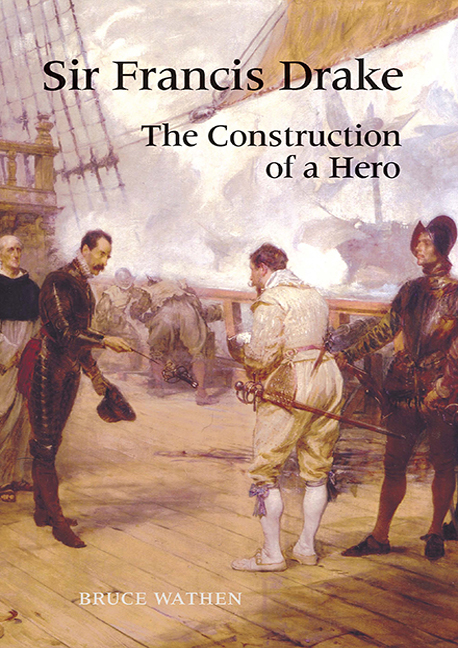Book contents
- Frontmatter
- Contents
- List of Illustrations
- Dedication
- Acknowledgements
- Introduction
- Chapter One Auxilio Divino
- Chapter Two ‘Sir Francis Drake Revived’
- Chapter Three ‘Behold the warrior dwindled to a beau’
- Chapter Four ‘Homage to Britannia’
- Chapter Five ‘Who the New World Bade British Thunders Shake?’
- Chapter Six ‘The Prose Epic of England’
- Chapter Seven ‘Mould him in bronze’
- Chapter Eight ‘Gun to Gun he'll Challenge us’
- Chapter Nine ‘A pirate, and a good one’
- Chapter Ten The Future
- Bibliography
- Index
Chapter Nine - ‘A pirate, and a good one’
Published online by Cambridge University Press: 11 May 2017
- Frontmatter
- Contents
- List of Illustrations
- Dedication
- Acknowledgements
- Introduction
- Chapter One Auxilio Divino
- Chapter Two ‘Sir Francis Drake Revived’
- Chapter Three ‘Behold the warrior dwindled to a beau’
- Chapter Four ‘Homage to Britannia’
- Chapter Five ‘Who the New World Bade British Thunders Shake?’
- Chapter Six ‘The Prose Epic of England’
- Chapter Seven ‘Mould him in bronze’
- Chapter Eight ‘Gun to Gun he'll Challenge us’
- Chapter Nine ‘A pirate, and a good one’
- Chapter Ten The Future
- Bibliography
- Index
Summary
Historians have long been at work to erode the reputation of that quasi-mythological figure Sir Francis Drake. His tactics have been criticized, his sense of strategy impugned and his contribution to the defeat of the Armada belittled.
(The Times, 24 January 1996)In the years between the world wars, the lateVictorian and Edwardian consensus of opinion on Drake began to break down. As we have seen, from the middle of the nineteenth century right up until the Great War, ‘high’ and popular culture had usually been united in fervent hero-worship of the great empire- building mariner. Academics such as Froude and Corbett were as fulsome in their praise of Sir Francis as popular poets like Newbolt and Noyes. But this convergence did not survive the First World War. It is generally accepted that, in the aftermath of the war,‘the literary culture of at least some parts of the intelligentsia had begun seriously to diverge from the common causes of the period before the First World War’. Although we cannot link those historians – particularly those naval historians – writing on Drake with the literary avant-garde, the huge disruption of the war appears to have had a marked effect on the practice of history-writing. Scholarly work concerned with Sir Francis Drake reveals a disengagement with empire or, at least, with the more elevated claims of the mythology that sustained it. During the 1920s there was a shift away from the epic scope of the nineteenth- century narrative of causation exemplified by Froude's History of England. Few accounts from this period dwell on the defeat of the Spanish Armada as the moment from which England's rise as an imperial power could be charted. Similarly, the hero-worship so characteristic of late nineteenth-century treatments of Drake was abandoned.
The move away from the metanarrative of England's rise to pre-eminence by many academic historians did not, however, result in a lacuna in the production of Drake material. Freed from his familiar role as a guarantor of empire, Sir Francis became the focus for renewed scholarly attention. But instead of manipulating the past to reinforce the grand narrative, historians began to seek out undiscovered documentary evidence and construct detailed narratives of individual voyages or single episodes from Drake's career.
- Type
- Chapter
- Information
- Sir Francis DrakeThe Construction of a Hero, pp. 163 - 178Publisher: Boydell & BrewerPrint publication year: 2009

